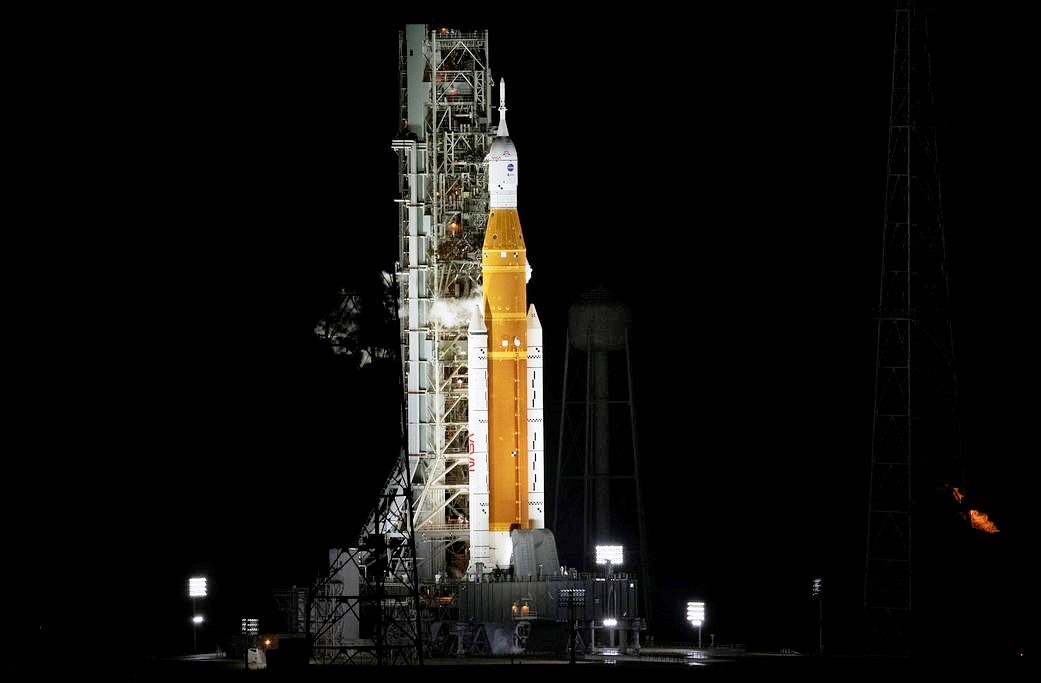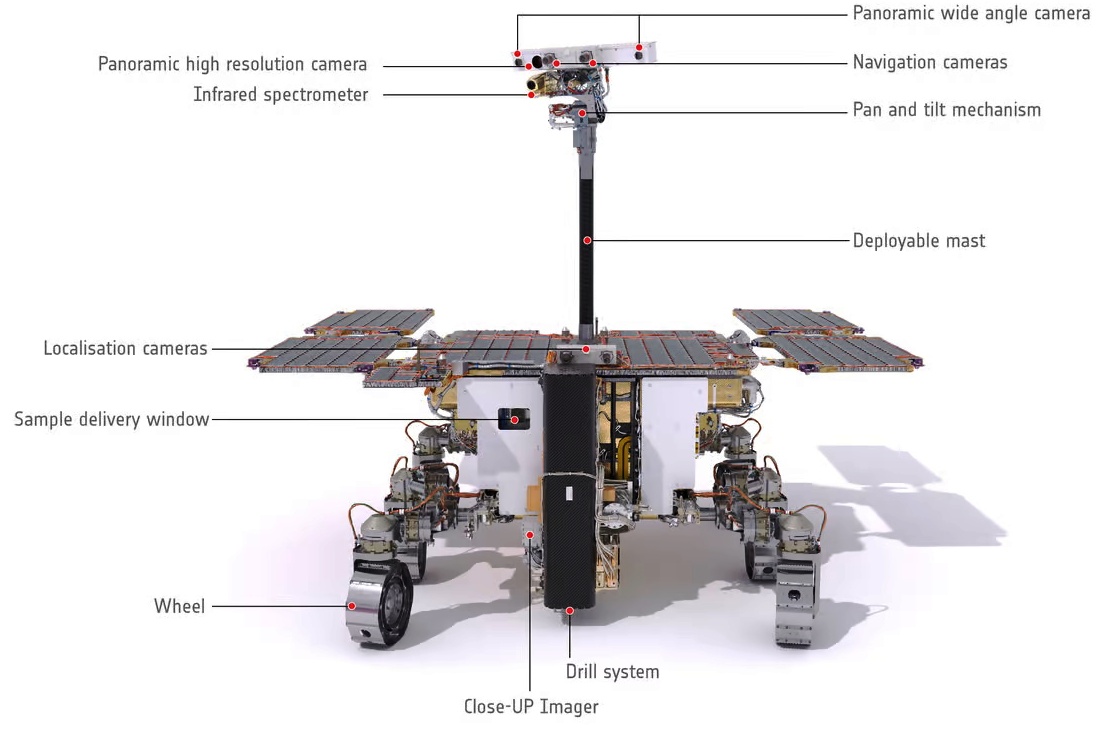Space Exploration 2022
2022 saw space exploration milestones
Ian Moss reviews three highlights…
Quick links to sections below:-
Introduction
The James Webb Space Telescope
Artemis
The Rosalind Franklin ExoMars Explorer
“The best-laid schemes o' mice an'
men
Gang aft agley,
An' lea'e us nought
but grief an' pain,
For promis'd joy!”
Robert Burns warned us in his poem “To a Mouse” about our expectations for a plan no matter how much ingenuity and effort we put into it. His words ring true today in space exploration as in any field of human endeavour.
2022 was seen as a year of great potential for the exploration of deep (I should say deepest) space and much nearer home targets in the Solar System. There has certainly been much disappointment but the resolve to overcome these difficulties is undimmed and in one case a newly launched, though much delayed, project of space exploration is producing spectacular and profound results.
So, let us start with success.
The James Webb Space Telescope (JWST)
After two decades of development and costing over 10 billion USD, the JWST finally launched on 25th December 2021. Originally planned to be sent on a Space Shuttle with its mirrors fully deployed, the JWST had to be re-designed to fit in Ariane 5 when the Shuttle program retired. This meant that the mirrors had to be folded to fit in the launch vehicle then remotely unfolded when positioned in space.
The tension of waiting for each stage of the deployment to be reported must have been indescribable for NASA personnel. It was high drama for all us casual observers on Earth.
We have all seen the extraordinary images the JWST is now sending to us and the NASA web site is constantly being up-dated with new glories of the Universe. The JWST “sees” orange, red and in the infra-red region of the electromagnetic spectrum. The reason for this is that the JWST is looking for phenomena billions of light years away in our rapidly expanding universe. A result of this expansion is red-shift, the phenomenon that causes the wavelengths of light from objects travelling apart at very high speed, to become longer.
An often-asked question is: are the colours we see in images from space, real?
Well.., it depends on what you mean by “real”. Our perception of colour of an object varies with many factors, including: distance, interference from other light emitting objects, the nature of the medium that the light passes through before reaching us and whether we view the object directly or via reproduction from a light sensitive medium, e.g.: traditional film or digital sensors and processing.
When we ask “are the colours real?”, I think what we really mean is, if an observer could travel close enough to an object in space so that to the naked eye it would appear the same size as the magnified image we obtained on earth, then would it appear to have the same colours?
A very difficult question to answer with accuracy because of the influencing factors touched on above. An important difference to consider concerning distance, is that on Earth we may observe a nebula exhibiting intense, bright colours simply because we are looking at the whole object, which may span many light years. If we were to move very close to an object, or go within a nebula, then our eyes or our telescopes would only collect light from a much smaller portion of the whole object. Consequently, colours which seemed intense on Earth, may now appear much weaker and, conversely, we may become aware of light that never reaches Earth.
To digress a little into biology: “seeing colour” is an illusion created by our brains in response to specific nerve signals from the retinas of our eyes. Our eye-brain co-operation interprets colour from a segment of the electromagnetic spectrum (the ”visible region”) covering wavelengths from about 380nm (the blue end) to 700nm (the red end). Why do we see in colour at all? There are, of course, evolutionary reasons. For example, the ability to perceive colours gives greater contrast between objects of similar brightness. In our distant pre-history this gave us the ability to more easily find things we liked to eat and helped us to avoid things that liked to eat us.
If we look at the Orion Nebula, easily seen through a telescope, we see a range of colours which we believe are real. Perfectly reasonable and largely accurate. However, our eyes have limited light capturing ability, so that we don’t detect faint light even from the visible region of the spectrum.
If we take a long-exposure digital image of the Orion Nebula, we may find that we have recorded visible wavelengths which we did not see with the telescope. That’s simply because a digital camera attached to a telescope has vastly greater light gathering capacity than our eyes.
So, in many cases the colours we see are real, more or less.
It is a different story with the JWST, here is one of its, now well known, images to help demonstrate the explanation.
The JWST detects light mostly in the infra-red region of the electromagnetic spectrum which our eyes are insensitive to. So where do the colours come from in this amazing image? In the case of the JWST images, data from different wavelengths in the infra-red undergo a process called mapping, which uses filters to separate and convert the different infra-red wavelengths to a range of wavelengths we can see. A way of thinking of this is to imagine that our eyes have a sensitivity range of 700 to 1020nm instead of 380-700nm. Our brains would interpret the same signals from our eyes so that wavelengths around 700 would seem blue to us and those around 1,000nm would seem red, with all the other colours we are familiar with being produced by the intermediate wavelengths. This is effectively what we are experiencing when we look at images from JWST; the colours are not real in our everyday sense. They do serve to differentiate the separate regions and enhance the detail of extraordinarily complex and beautiful phenomena. The Carina Nebula, as shown here (see above), would be nowhere near as astonishing if presented in shades of grey.
Artemis
We turn to a project which has had its problems and is yet to, literally, get off the ground but the auspices are improving.
People are going to walk on the Moon again and not in the too distant future. NASA’s Artemis project is starting the process by testing an uncrewed flight using a rocket known as the Space Launch System (SLS). The SLS program was started in 2011 with a target of 2016 for the first launch. The programme has been dogged with delays (about twenty over the past six years) and controversy, not the least of which is that the rocket uses modernised, repurposed, left-over engines form the Shuttle programme. This has been seen by some parties with a commercial interest as “uncompetitive”.
The SLS is massive, although at 98m tall and weighing around 2.5 million kg it is smaller than the Saturn V rockets (110m and 2.8 million kg) that took astronauts to the Moon in the 1960s and 1970s. However, the SLS is more powerful with 3.9 meganewtons of thrust compared to the 3.3 meganewtons of the Saturn V. Sitting atop the SLS is the Orion lunar capsule; the name reflects the love story of Artemis and Orion from Greek mythology.
Artemis 1 was originally planned to launch in May 2022 but delayed until late August. Then lift-off was repeatedly dogged by last minute problems with the liquid hydrogen fuel loading and tank pressure. NASA has at last overcome these difficulties but the new launch date of 28th September 2022 was then cancelled because of the arrival of Hurricane Ian.
It is unlikely that the SLS will launch before November 2022. Artemis 1 will then, hopefully, set off for the Moon and depending on the precise position of the Earth and Moon at that time, will take 2.5 to 4 days for Orion to enter lunar orbit. A total mission time of about 42 days is scheduled during which time the capsule will orbit the Moon at about 68,000 km above the surface but will also make close fly-bys of the lunar surface at a height of just 100km. Eventually Orion will to return to Earth for splash-down in the Pacific Ocean.
In 2023, the flight will be replicated by Artemis 2 but with a crew of 4 on board. Then in 2024 Artemis 3 will hopefully see a landing and moon walk by a crew that will be the first to put foot on the lunar surface since Apollo 17 in December 1972.
The future of the SLS system is ambitious. This current programme is seen as preparation for crewed flights to Mars. By this time next year NASA’s plans for Artemis will, hopefully, be demanding our attention and capturing our imaginations.
The Rosalind Franklin ExoMars Explorer
In 2013 the European Space Agency (ESA) and Roscosmos, the Russian space agency, undertook a joint project, ExoMars, to send a robotic probe to Mars. Russia was to provide the launch vehicle and the landing craft, named Kazachok, and ESA was to build the Mars rover and its instruments. The rover was named after Rosalind Franklin, a renowned pioneer of research into the structure of DNA. An appropriate choice, as the ExoMars project’s principal mission is to search for signs of past life on Mars.
Originally planned to launch in 2018, problems with the landing craft parachutes put the date back to 2022. However, this was cancelled because of events in Europe. The ESA has now severed ties with Russia and is seeking a new launch vehicle and landing craft with a projected launch date in 2028. A ten-year delay from the originally planned date.
We have a long wait but the ExoMars rover will eventually provide a vast array of different types of data from its many instruments. Although an ESA project, there are also technological contributions from Canada and the USA. Instruments will include: high resolution wide angle and close up cameras, ground penetrating radar, a novel organic molecule detection system, a visible region spectrometer and infra-red and Raman spectrometers. A miniature infra-red spectrometer will be integrated into a sub-surface drill. To date the deepest that any Mars rover has drilled into the Red Planet is 7cm. The Rosalind Franklin drill has been tested on Earth to a depth of 1.7m. At this depth remains of extinct life may be found and also perhaps, living organisms.
The image below gives a good view of how so much technology is integrated into a rover about 3m long and 3m wide and a little over 2m tall.
Now we have a long wait for the “best-laid schemes” of the ExoMars project to come to pass and perhaps answer the question that constantly fascinates, “Is there life on Mars?”
Ian Moss
Ian Moss is retired from a career in biotechnology. He is an amateur astronomer with a particular interest in imaging planets and deep-space objects, mostly from his home in a light-polluted London suburb! Ian is a member of Havering Astronomical Society which has a membership spanning from beginners to professionals. The Society is active in out-reach to the local community.
[Up: Article Index | Home Page: Science Fact & Fiction Concatenation | Recent Site Additions]
[Most recent Seasonal Science Fiction News]
[Convention Reviews Index | Top Science Fiction Films | Science Fiction Books]
[Science Fiction Non-Fiction & Popular Science Books]


